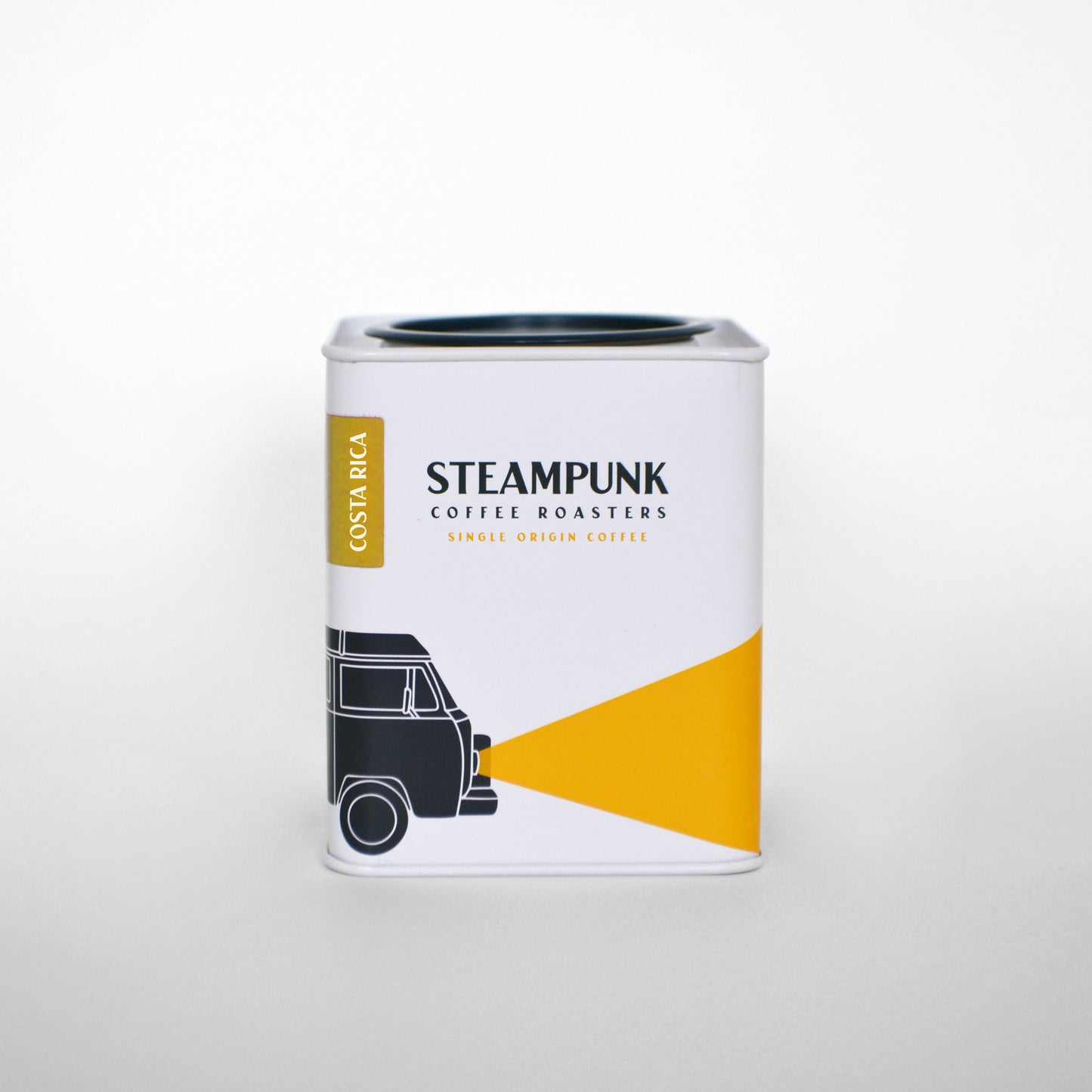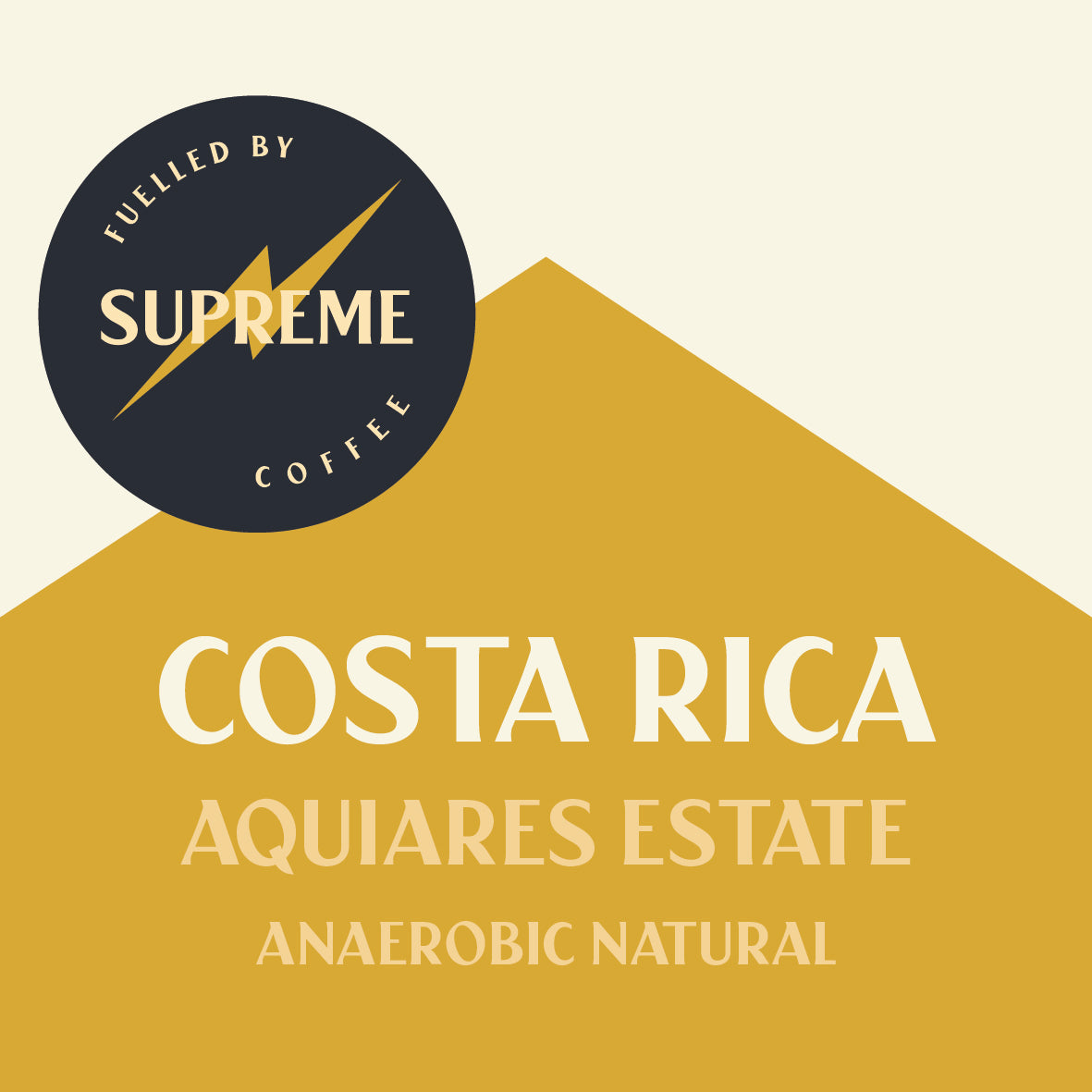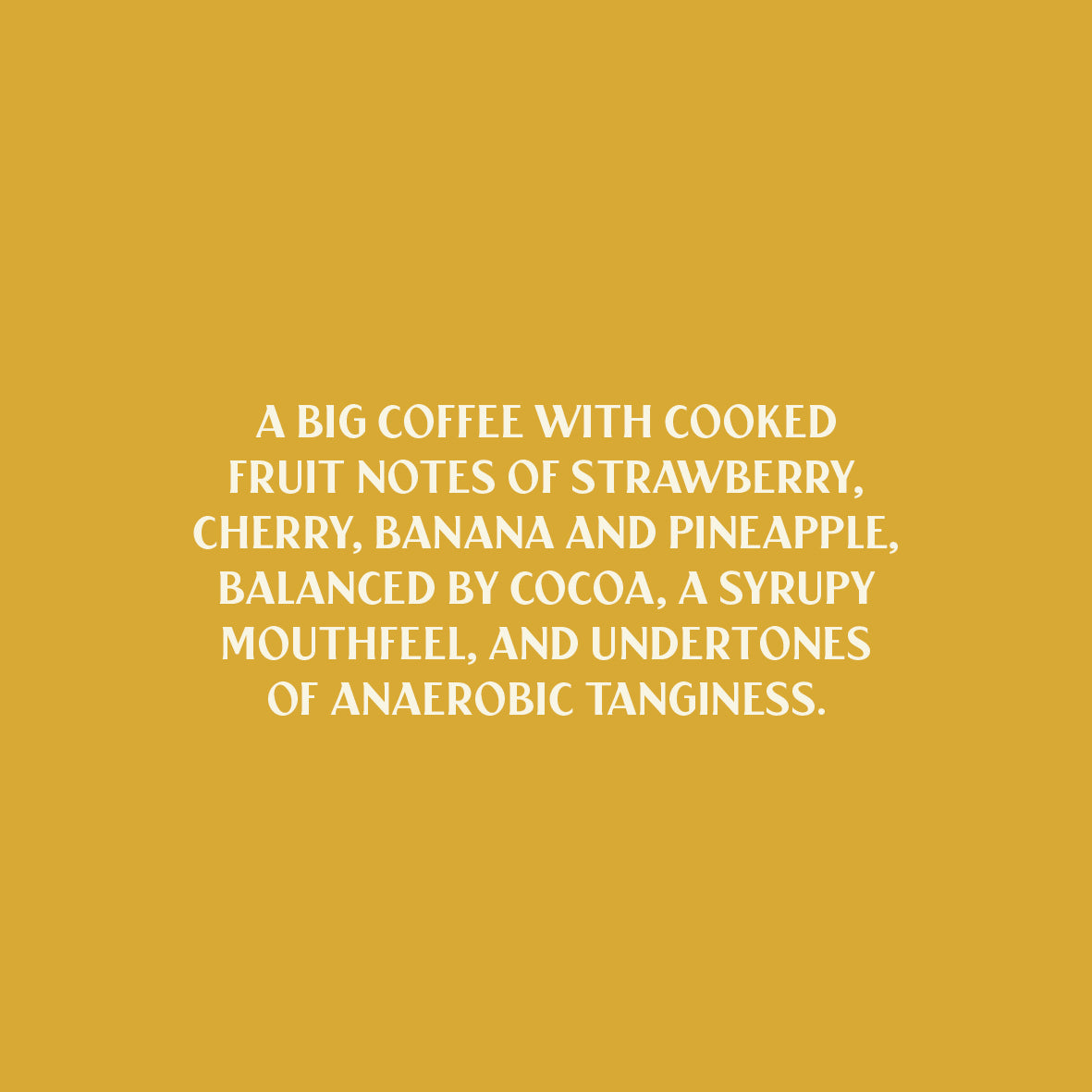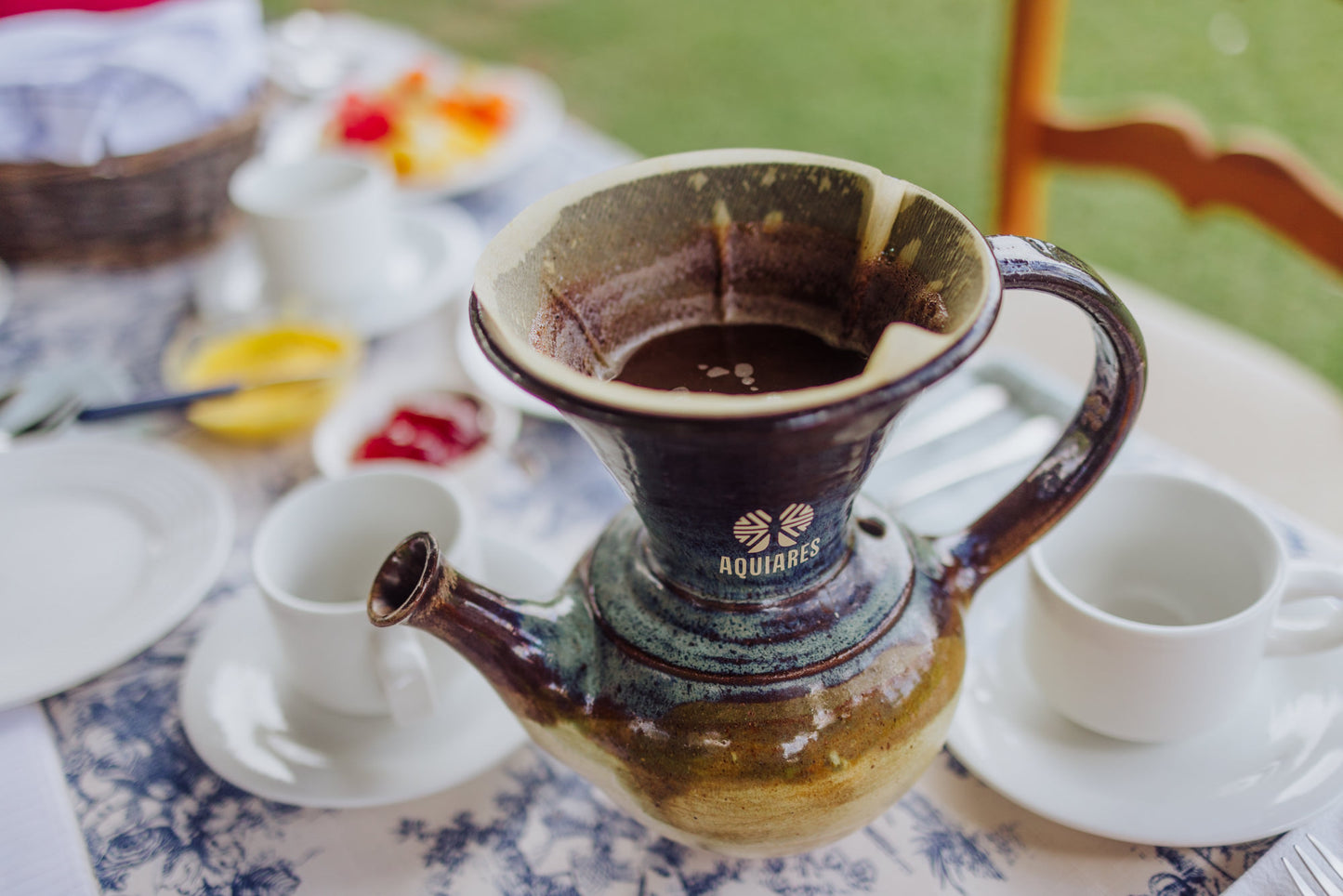Steampunk Coffee Roasters
Costa Rica Aquiares Estate
Costa Rica Aquiares Estate
Couldn't load pickup availability
Region: Turrialba
Altitude: 1100-1400 m.a.s.l.
Variety: Marsellesa, Obatá
Processing: Anaerobic Natural
UK Arrival: June 2025
Tasting Notes: A big coffee with cooked fruit notes of strawberry, cherry, banana and pineapple, balanced by cocoa, a syrupy mouthfeel, and undertones of anaerobic tanginess.
This is our third lot from Aquiares Estate but, in a departure from our usual style, it’s the first to be processed using anaerobic fermentation. You’ll taste the same vibrant fruit and syrupy body but with the added tanginess typical of this processing method. If you’re new to process-driven coffees, this is a top notch introduction.
Our head of coffee met Diego Robelo, general manager of the estate, in 2024. She was struck by his energy and drive for improvement. As the oldest coffee estate in Costa Rica, they have extensive expertise in coffee production. Both of these—their experience and innovation—show in their coffees. They’re also industry leaders in social welfare and environmental stewardship.
Picking and Processing
The harvest in Costa Rica runs from October to March, but in the Turrialba region where this coffee was grown, the flowering and harvest happen a little earlier. All Aquiares coffee is picked by hand to ensure consistent high quality. Microlots, such as this one, are picked by a team of skilled harvesters who are paid well above the daily rate for their skill in picking the ripest cherries at each pass. Each tree is visited up to seven times during the harvest to ensure that only fully red, ripe cherries are picked.
The same day they’re picked, the cherries are taken to Aquiares’ wetmill where processing begins. Anaerobic natural lots are floated for density and then put into plastic barrels for fermentation. The barrels are put in a shaded, cool place in the mill, completely sealed and fitted with a bubbler, which allows gases to escape. Sealing the fermenting coffee with a one-way valve creates an anaerobic environment, meaning without oxygen. Temperature and pH are checked twice a day, and once the coffee reaches a pH of 4.3 (after one to two days), the barrels are opened and the cherry is taken to the drying station.
For this lot, there are three stages of drying. First, the fermented cherry is pre-dried for two days on cool, clean ceramic floors. Next, it is taken to raised beds in a specialty designed greenhouse where the temperature is kept between 28℃ and 40℃ for 10 days. Finally, the coffee is placed in a mechanical dryer known as a guardiola for the final day.
Aquiares developed this intensive drying program partly as a result of the humid climate in the region, which makes drying a natural coffee like this one a challenge. According to Diego, “Everyone told us we were crazy. You are never going to make honeys and naturals in Turrialba. We decided to prove them wrong.”
He sourced a greenhouse from a neighbour in the region who had been producing roses and built drying beds according to specifications gleaned from other producers. After the first lots were dried in the greenhouse, thermometers and humidity gauges still showed a great deal of temperature fluctuation depending on the time of day and weather. To create a constant, even temperature in the greenhouse they installed an airflow system connected to their guardiola system. Now, dry air of around 36℃ circulates throughout the greenhouse, maintaining an even temperature. The system works well, helps increase the drying capacity of the greenhouse and reduces variability in lots.
Variety
This coffee is a blend of Red Obatá and Marsellesa varieties, both of which are hybrids of Villa Sarchi and Timor Hybrid and belong to a group of hybrids from that parentage that are collectively known as Sarchimor. Aquiares has found these two varieties very well-suited to the farm’s elevation and great for marrying both high cup quality with strong resistance to disease. In fact, these hybrids were first developed in an effort to find a plant that would be resistant to leaf rust. Obatá was developed in Brazil by the Instituto Agronomico (IAC) of Sao Paulo State in Campinas and was released in 2000. In 2014 it was launched in Costa Rica by the Costa Rican Coffee Institute (ICAFE). Marsellesa was developed through a partnership between a private commodity firm called ECOM and the French Agricultural Research Centre for International Development (CIRAD). It was released in Nicaragua in 2009 and is known for its high yield and high acidity in the cup.
Entre Rios, translating as “between rivers”, is the name that Aquiares gives its lots that are Obatá and Marsellesa.
Producer
Aquiares Estate sits high on the fertile slopes of Turrialba Volcano. Established by British farmers in 1890, Aquiares was one of the first estates to produce and export Costa Rican coffee. In 1971, the farm was purchased by its current owners—three families who have worked together with the farm’s staff and community to implement a modern model of sustainable agriculture. The farm manages the entire coffee production chain, from seedling production to plant cultivation, harvesting and milling.
The farm’s terrain varies from gently sloping to steep hills. Valleys between hills create microclimates that are ideal for growing mainly Caturra and grafted Arabica-Nemaya varieties. Although Aquiares is considered large under Central American standards, the farm’s belief is that it is crucial to tend to every individual coffee plant’s needs. Therefore, Aquiares utilises a system of pruning each plant independently, instead of pruning by row or lot. Through an intensive rehabilitation program, Aquiares has re-planted more than 400,000 coffee trees in small patches of existing fields. This rejuvenated the crop of trees and increased the land’s utilisation. It also played a crucial role in the 2012 rust attack, as young plants resisted the disease better, slowing its spread.
Environmental Stewardship
In 2012, Aquiares became the first farm in Costa Rica to fulfil the requirements of the Rainforest Alliance Climate Module. Since 2015 the farm has operated as carbon neutral, most years achieving negative carbon emissions.
Aquiares is strongly committed to, and has become an international leader in, environmental sustainability. The farm has long seen the connection between agricultural, environmental and social health. By planting more than 50,000 shade trees, creating natural buffers around streams and water springs, preserving the river valleys as forest, planting along the contour, implementing integrated pest management systems and many other steps, Aquiares has demonstrated how to make ecological ideals a reality. For example, given that soil health is the most important factor for a successful farm, Aquiares takes many steps to naturally improve the farm’s volcanic soil. The organic matter from pruning and the leaf litter from the coffee and shade trees are left to feed soil microbes and provide organic nutrients. The diversified shade trees (over 40 species) also cool the ground, slowing the ripening of the coffee, which allows for sugars from the mucilage to be fully absorbed by the bean, thus improving cup quality. The farm’s agricultural objective is to find synergies like these, where environmental health translates into coffee plant health, which ultimately contributes to a long-term stability in the production of high-quality coffee.
Social Welfare
The modern focus on the social welfare of the farm workers and the wider community is a main priority of the Robelos and their co-owners and is in contrast to the estate’s colonial roots. Originally, the farm owned the houses where employees lived, but in 1992, under Don Alfonso’s management, the farm started a project to enable people to own their own houses. Each worker was given a bonus for his or her years of service, lots were priced at a fraction of the local rate, and assistance was given to apply for a government house fund. Today, around 15% of Aquiares residents work on the farm (many have gone on to become school teachers, doctors, etc) and 96% of these own their own home, giving them the option to take a path for their future of their own choice. The town has its own school, youth sports program, recycling committee, early childhood nutrition centre and a church built in 1925, which is a National Architectural Historic Monument. Their website states, “The coffee farm and the community are one in Aquiares, both are dependent on each other.”
According to Aquiares, the skilled hands of the pickers represent the farm’s most valuable asset. During the harvest pickers hail from the community of Aquiares, nearby towns and even from the neighbouring countries of Nicaragua and Panama. The farm ensures that all workers have a safe work environment and a comfortable place to live. Workers coming from further away can live in onsite housing and use a children’s daycare. The farm sponsors doctor’s visits for pickers and their families twice a week where nutritional health advice is also given.To take better care of its field workers, Aquiares has established first-of-its-kind physical therapy sessions and also a daily warm-up routine of exercise before work. Many pickers return each year,confirming success in providing a secure home in Aquiares.
Research and Innovation
Aquiares has been home to research studies for decades, starting with sociological studies in the 1950s. More recently, numerous scientific studies have been conducted at Aquiares. In 2007, the farm was among the very first to try to calculate its carbon balance. Today, Aquiares is the main test plot for an ongoing project between the CIRAD Institute of France and CATIE University of Costa Rica. The Carbon-Flux Project measures greenhouse gas exchange between the farm plot and the atmosphere over long term time scales. This research station is the only one of its kind in the world, capable of accurately measuring the emission-sequestration balance of a hectare of shaded coffee. With this tool, the researchers are trying to develop a model that can be used by any coffee farmer in the world to estimate the carbon sequestration potential of their farm. This project is part of the Intergovernmental Panel on Climate Change research efforts.
Aquiares Estate 🇨🇷 Costa Rica (@aquiarescoffee) • Instagram photos and videos
5th Wave Podcast with Diego Robelo
https://share.transistor.fm/s/adb40862
YouTube - Meet the Farmer
https://youtu.be/xQ9j-CaVtWc?si=azjRuIco83rrIR1h
A note about packaging
Our coffee comes packaged in beautiful and hard wearing tins. It is important to keep those beans away from air and light (see our blog post about coffee storage) and we think tins are the very best way of keeping those guys fresh.
Tins can of course be easily recycled (with other metals) but the very best and most environmentally conscious thing to do with them is to refill them. Find out how to refill or dispose of your Steampunk packaging HERE.
Share




















